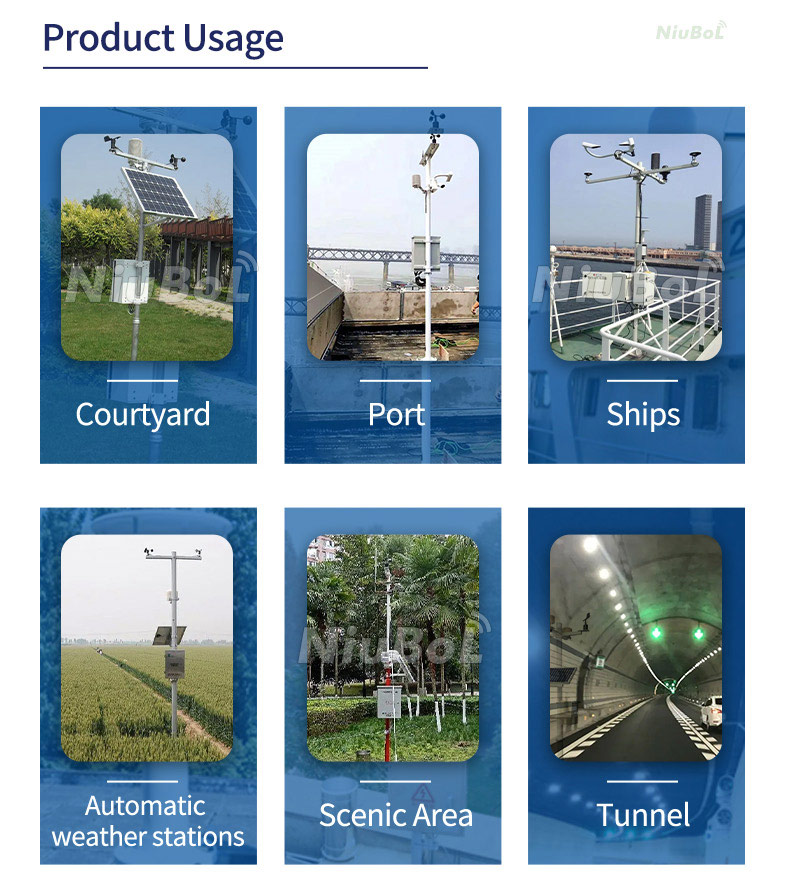

— Blogs —
—Products—
 Consumer hotline +8618073152920
Consumer hotline +8618073152920 WhatsApp:+8615367865107
Address:Room 102, District D, Houhu Industrial Park, Yuelu District, Changsha City, Hunan Province, China
Product knowledge
Time:2024-08-11 18:52:24 Popularity:1379
A wind speed sensor is a device used to continuously monitor wind speed and volume, and its operating principle varies depending on the type. Following are the working principles of several major types of wind speed sensors:
- This type of sensor utilizes the principle that the blade system rotates by wind pressure. When the wind acts on the blades, a torsional moment is generated to rotate the blades around a horizontal axis.
- A set of three-blade or four-blade propellers are installed in the front of the wind vane to ensure that the rotating surface is always aligned with the wind direction, and its rotational speed is proportional to the wind speed.
- First invented by the British Rubinson, it uses three or four hollow cup-shaped structure, these cups are fixed in each other at a certain angle (such as 120 ° or 90 °) on the bracket, rotating around the vertical axis.
- When the wind comes, the concave side of the wind cup facing the wind, to withstand greater wind pressure, while the convex side or the side of the wind to the wind of the wind pressure is small, resulting in a pressure difference, prompting the wind cup rotation. The greater the wind speed, the faster the wind cup rotates.
- After the wind cup starts to rotate, with the wind speed stabilized, the wind pressure difference reaches equilibrium, the wind cup enters the state of uniform rotation, and its rotational speed reflects the wind speed.
- Based on the principle of heat dissipation and convection heat transfer, there is a heating element in the sensor surrounded by temperature sensors.
- When the wind speed increases, the heat of the heating element is taken away more quickly, resulting in a change in temperature, and the wind speed can be deduced by measuring this change.
- Suitable for measuring the velocity of gas flow, utilizing the difference between static and dynamic pressure. The Pitot tube has two openings, one measuring the total pressure (dynamic + static) and the other measuring the static pressure.
- The wind speed is calculated by the difference between the two, suitable for occasions that require high precision measurement.
- Utilizing the principle that the propagation speed of ultrasonic waves in the air is affected by wind speed. The sensor transmits and receives ultrasonic signals, and calculates the wind speed by measuring the difference in the propagation time of ultrasonic waves in the wind direction.
- Because ultrasonic waves propagate at different speeds in the downwind and upwind directions, this difference can be converted into wind speed information.

1. Meteorological monitoring: Used in weather stations to monitor meteorological data such as wind speed and direction, providing data support for weather forecasting and climate change research.
2. Wind power generation: Provide wind speed data for wind turbines to optimize power generation efficiency and reduce resource waste.
3. Nautical aviation: Provide wind speed and direction data for nautical ships and airports to ensure navigation safety and enhance navigation efficiency.
4. Environmental monitoring: monitoring wind speed changes, assessing environmental pollution, and providing scientific basis for environmental protection.
5. Bridges and tunnels: monitoring structural wind loads to ensure traffic safety and facility stability.
6. urban planning: help city managers accurately grasp the air quality and wind speed and direction changes, providing a scientific basis for urban planning and environmental protection.
7. Agriculture: monitoring wind speed in farmland, providing suitable environmental conditions for crop growth and improving agricultural production efficiency.
8. Scientific research: used for wind tunnel experiments, wind field simulation and other scientific research, providing data support for research in related fields.
9. Energy management: monitoring wind energy resources, providing data support for wind energy power generation projects, and realizing the efficient use of energy.
10. Disaster Early Warning: Monitoring the wind speed changes in extreme weather conditions, providing data support for disaster prevention and mitigation.
Choosing the right wind speed sensor and using it correctly can help users accurately understand the wind speed situation and provide reliable data support for the work in related fields.
In summary, the selection of wind speed sensors should be based on their diverse working principles and applicable scenarios. Users should select the most suitable wind speed sensors based on actual needs, taking into account factors such as measurement accuracy, response time, cost-effectiveness and ease of maintenance. These sensors are designed to provide accurate and stable wind speed measurements for a wide range of applications, including meteorological observation, wind power generation, navigation and aviation, environmental monitoring and other key areas, to ensure the accuracy and reliability of the data.
NBL-W-SS-Wind-Speed-Sensors-Instruction-Manual.pdf
NBL-W-DS-wind-direction-sensor-Manual.pdf
NBL-W-SDS Integrated wind speed and direction sensor User manual.pdf
Related recommendations
Sensors & Weather Stations Catalog
Agriculture Sensors and Weather Stations Catalog-NiuBoL.pdf
Weather Stations Catalog-NiuBoL.pdf
Related products
 Combined air temperature and relative humidity sensor
Combined air temperature and relative humidity sensor Soil Moisture Temperature sensor for irrigation
Soil Moisture Temperature sensor for irrigation Soil pH sensor RS485 soil Testing instrument soil ph meter for agriculture
Soil pH sensor RS485 soil Testing instrument soil ph meter for agriculture Wind Speed sensor Output Modbus/RS485/Analog/0-5V/4-20mA
Wind Speed sensor Output Modbus/RS485/Analog/0-5V/4-20mA Tipping bucket rain gauge for weather monitoring auto rainfall sensor RS485/Outdoor/stainless steel
Tipping bucket rain gauge for weather monitoring auto rainfall sensor RS485/Outdoor/stainless steel Pyranometer Solar Radiation Sensor 4-20mA/RS485
Pyranometer Solar Radiation Sensor 4-20mA/RS485
Screenshot, WhatsApp to identify the QR code
WhatsApp number:+8615367865107
(Click on WhatsApp to copy and add friends)
